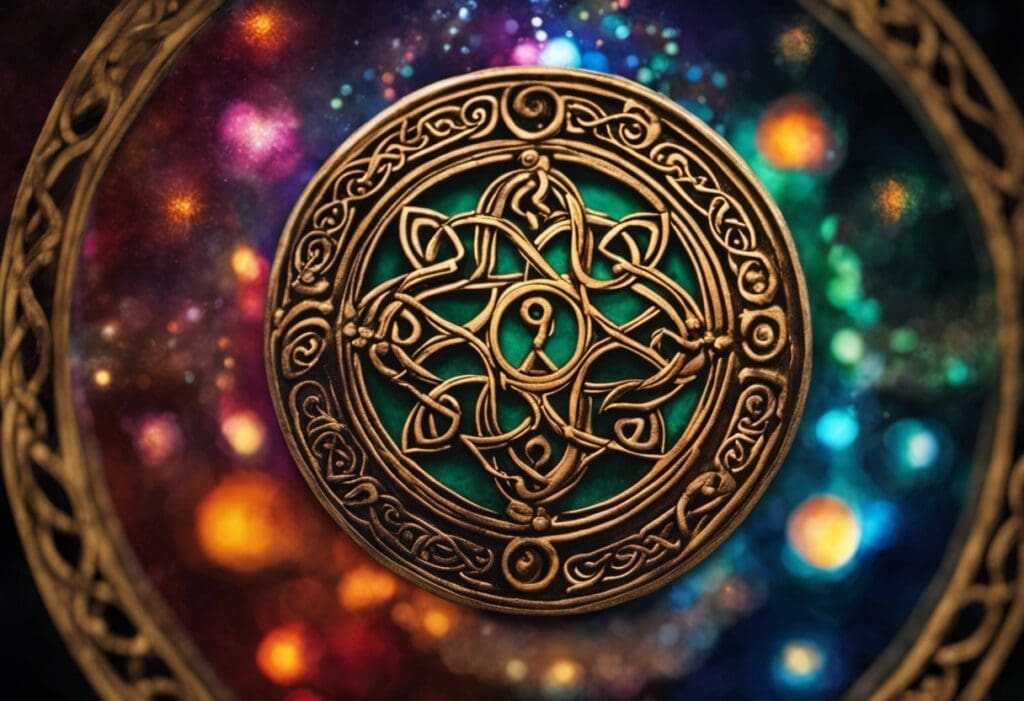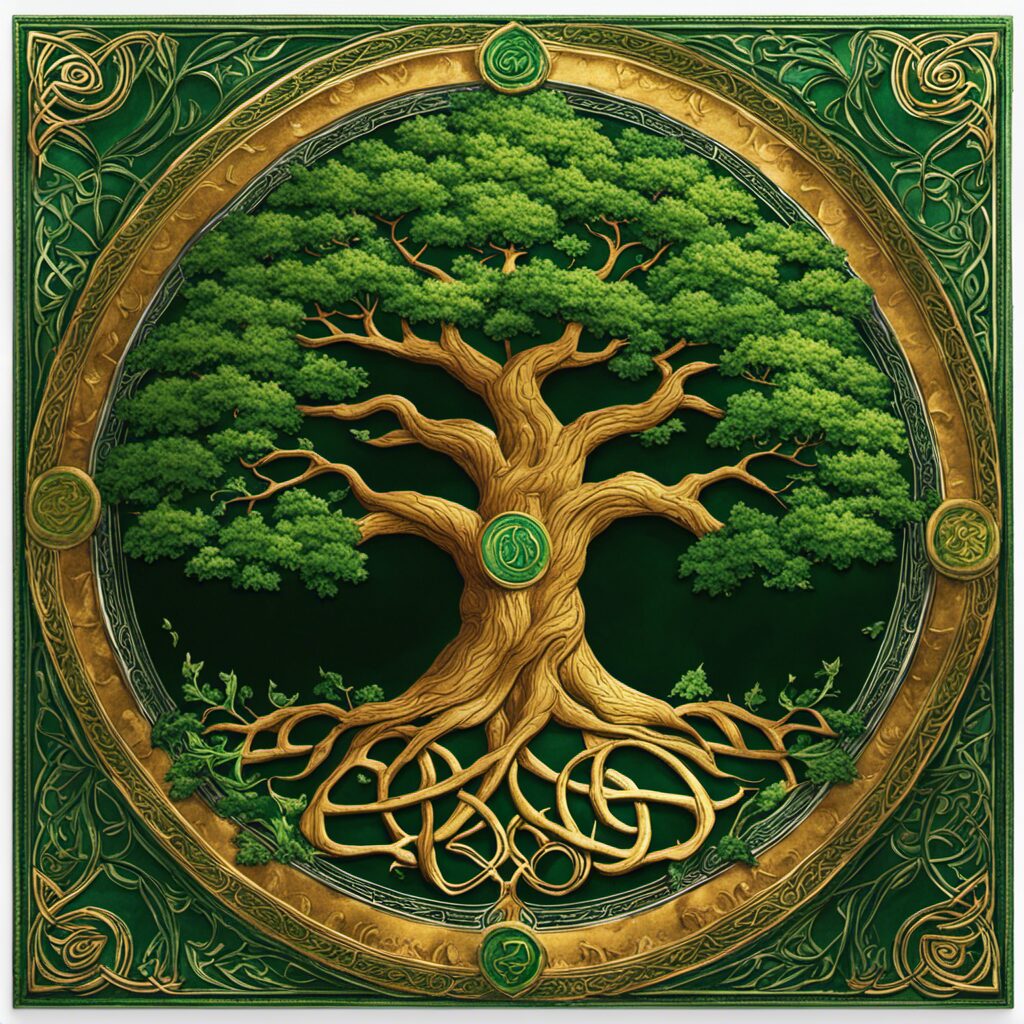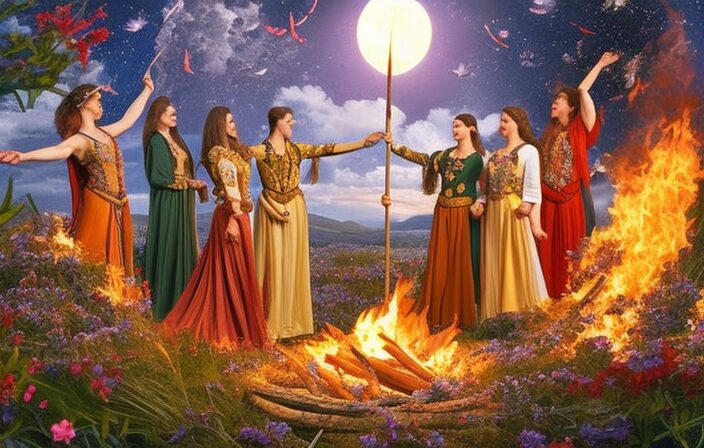In the realm of ancient Celtic spirituality, the calendar held a profound significance. It served as a guiding force for understanding the cyclical nature of life and connecting with spiritual energies.
This article explores the esoteric aspects of the Celtic calendar, delving into its origins and uncovering its hidden powers. By examining the lunar cycle, solstices, equinoxes, and tree calendar, we can gain insight into how to integrate Celtic calendar magic into our everyday lives and cultivate a deeper connection with the spiritual realms.
Key Takeaways
- The Celtic calendar originated in the early Iron Age and was closely tied to agricultural practices and religious beliefs.
- Each phase of the moon holds distinct properties and significance in Celtic rituals.
- The solstices and equinoxes play a significant role in Celtic calendar rituals, connecting with cosmic forces and symbolizing the balance between light and darkness.
- Participating in Celtic festivals, rituals, and ceremonies deepens the spiritual connection and fosters personal growth.
The Ancient Origins of the Celtic Calendar
The ancient origins of the Celtic calendar can be traced back to the early Iron Age in Western Europe. The Celts were a group of people who inhabited this region during that time and had a rich cultural heritage. Their calendar was closely tied to their agricultural practices and religious beliefs, with specific dates marking important events and celebrations throughout the year.
Ancient Celtic celebrations played a significant role in their society, as they were deeply connected to nature and believed in the spiritual significance of certain days. These celebrations often revolved around the changing seasons, such as Beltane marking the beginning of summer or Samhain signaling the start of winter. They would gather together to honor these transitions, performing rituals and ceremonies to ensure fertility, protection, and prosperity for their communities.
The cultural significance of the Celtic calendar cannot be understated. It served not only as a practical tool for organizing daily life but also as a means to connect with their ancestral traditions and spiritual beliefs. Through observing the cycles of nature reflected in their calendar, they sought harmony with the natural world and sought guidance from higher powers.
Understanding the Lunar Cycle in Celtic Calendar Magic
Understanding the lunar cycle in relation to the Celtic calendar system involves analyzing the various phases of the moon and their significance within this specific magical practice. The lunar phases play a crucial role in Celtic rituals, as they are believed to hold spiritual powers that influence the outcome of these ceremonies. The moon is considered sacred by Celts, symbolizing femininity, intuition, and emotional energy.
In Celtic calendar magic, each phase of the moon holds distinct properties and is associated with different aspects of life:
-
New Moon: This phase represents new beginnings and fresh starts. It is a time for setting intentions, starting projects, or embarking on new ventures.
-
Waxing Crescent: As the moon begins to grow in size, it signifies growth and expansion. This phase is ideal for nurturing ideas or relationships and enhancing personal development.
-
Full Moon: The full moon is a time when energies reach their peak. It is associated with abundance, manifestation, and completion of goals.
-
Waning Gibbous: During this phase, the energy starts to decrease. It is a period for releasing negativity or letting go of things that no longer serve us.
-
Dark Moon: Also known as the ‘dark night of the soul,’ this phase represents introspection and inner reflection. It offers an opportunity for deep healing and transformation.
Harnessing the Power of the Solstices in Celtic Calendar Rituals
Harnessing the power of the solstices involves incorporating specific rituals and practices into the Celtic calendar system to mark significant astronomical events. The solstices, which occur around June 21st (summer solstice) and December 21st (winter solstice), are important celestial occurrences that have been celebrated by various cultures throughout history. In Celtic calendar magic, these solstices hold special significance as they represent major turning points in the natural cycle of the year.
To harness solstice energy, ancient Celts performed a variety of rituals to honor and connect with the cosmic forces at play during these times. One common ritual was the lighting of bonfires, symbolizing purification and renewal. These fires were believed to ward off evil spirits and bring blessings for a prosperous future. Additionally, participants would often engage in communal ceremonies involving dance, music, and feasting to celebrate the abundance of nature.
Rituals for solstice celebration also included divination practices such as scrying or casting lots to gain insight into future events. This allowed individuals to seek guidance from higher powers or deities regarding personal matters or community concerns. Furthermore, offerings were made to gods or goddesses associated with fertility and harvest to ensure bountiful crops in the coming months.
Harnessing the power of the solstices through these rituals not only connected individuals with cosmic energies but also reinforced their connection with nature and their place within it. By aligning themselves with celestial events through carefully crafted practices, ancient Celts sought harmony within themselves and their environment while embracing their spiritual heritage.
Exploring the Equinoxes and Their Significance in Celtic Spirituality
The Equinoxes hold great significance in Celtic spirituality, as they mark the balance between light and darkness. These celestial events are celebrated through rituals and symbolism that connect individuals to the rhythms of nature and the spiritual world.
Equinox Rituals and Symbolism
Equinox rituals and symbolism play a significant role in the esoteric practice of Celtic calendar magic. The equinox, occurring twice a year during spring and autumn, holds deep spiritual significance for Celtic practitioners. Symbolically, the equinox represents balance, as it marks the point where day and night are equal in length. This balance is often associated with harmony and unity within oneself and with nature.
Equinox rituals are performed to honor this celestial event and tap into its potent energies. These rituals may include:
- Lighting bonfires or candles to symbolize the returning light or the descending darkness
- Performing dances or chants to invoke fertility and abundance
- Creating mandalas or altars adorned with seasonal flowers and herbs
- Engaging in meditation practices focused on finding inner equilibrium
Ultimately, these rituals aim to connect practitioners with the cyclical nature of life and foster spiritual growth.
Celtic Spiritual Connection
Cultivating a deep connection to Celtic spirituality involves practices that honor and engage with the cyclical rhythms of nature. One way in which this is achieved is through the study and observance of Celtic astrology, which plays a significant role in understanding one’s spiritual path and personal characteristics.
In Celtic astrology, each month is associated with a specific tree or plant, embodying unique qualities and energies. By aligning oneself with the energy of these trees, individuals can tap into their inherent wisdom and harness their power for personal growth and transformation.
Furthermore, Celtic festivals also serve as important opportunities for spiritual connection. These festivals are based on the ancient Gaelic calendar, which divides the year into four major seasonal celebrations known as Imbolc, Beltane, Lughnasadh, and Samhain. Each festival marks an important moment in the agricultural cycle and offers a chance to connect with ancestral traditions while honoring the natural world.
Through participating in rituals, ceremonies, and communal gatherings during these festivals, individuals can deepen their spiritual connection to both their ancestors and the land they inhabit.
Unveiling the Secrets of the Celtic Tree Calendar
Unveiling the Secrets of the Celtic Tree Calendar allows for a deeper understanding of the spiritual significance and symbolism associated with each tree. This ancient calendar system, rooted in Celtic traditions, not only provided a practical way to mark the passing of time but also held deep mystical significance. The Celtic people believed that each tree had its own unique energy and personality, which influenced human experiences and connected them to the natural world.
To fully grasp the depth of this mystical practice, it is essential to explore some key aspects of Celtic tree symbolism:
-
Tree Associations: Each month in the Celtic calendar corresponds to a specific tree, which represents different qualities and characteristics. For example, Birch is associated with new beginnings and purification, while Oak symbolizes strength and endurance.
-
Ogham Alphabet: The Ogham alphabet is an ancient writing system used by the Celts. It consists of a series of lines or notches representing individual letters carved onto wooden staves or stones. These inscriptions often relate to specific trees or plants.
-
Tree Lore: The mythology surrounding each tree reveals insights into their symbolic meanings. For instance, Yew was regarded as a guardian between life and death due to its longevity and association with graveyards.
-
Healing Properties: Many trees were valued for their medicinal properties in Celtic culture. Willow bark, for example, contains salicylic acid – an ingredient found in aspirin – making it useful for pain relief.
-
Divination Practices: The Celts used various methods such as scrying (looking into reflective surfaces) or interpreting patterns created by fallen leaves to gain insight into future events.
Deepening Connection With the Celtic Calendar Through Sacred Ceremonies
Sacred ceremonies provide a means to deepen one’s connection with the Celtic calendar, fostering a greater understanding of its cultural significance and practical applications. These rituals are an integral part of Celtic spirituality, allowing individuals to engage in spiritual practices that align with the natural rhythms of the earth and the seasons.
By participating in these sacred rituals, individuals can tap into the wisdom and power of the Celtic calendar, enhancing their spiritual journey and personal growth.
One such sacred ritual is the celebration of the eight seasonal festivals known as Sabbats. These festivals mark important points in the agricultural year and are deeply rooted in Celtic tradition. They include Samhain (October 31st), Imbolc (February 1st), Beltane (May 1st), and Lughnasadh (August 1st), among others. Each festival has its own unique customs, symbolism, and rites that connect individuals to nature’s cycles.
Engaging in these sacred rituals provides an opportunity to honor ancestral traditions while also connecting with contemporary spiritual practices. By observing these festivals through ceremonies such as bonfires, feasts, dancing, or meditation, individuals can experience a deep sense of belonging and connection with both their ancestors and their environment.
Moreover, these sacred ceremonies offer practical applications beyond just cultural significance. They serve as moments for reflection, intention setting, healing work, or manifestation exercises. The energy generated during these rituals can be harnessed for personal transformation or collective healing.
Integrating Celtic Calendar Magic Into Everyday Life
The integration of Celtic calendar magic into everyday life can be achieved through the practice of practical rituals. These rituals serve as a means to connect with and honor the spiritual energies associated with each season, festival, or celestial event within the Celtic calendar.
By incorporating these rituals into daily routines, individuals can experience a greater sense of harmony and alignment with nature, as well as tap into the transformative potential that comes from working in rhythm with the cycles of the earth.
Furthermore, cultivating awareness of the Celtic calendar not only fosters a deeper connection to ancestral wisdom but also provides numerous benefits such as increased mindfulness, enhanced personal growth, and a greater appreciation for the interconnectedness of all things.
Practical Rituals for Integration
Practical rituals for integration in the esoteric Celtic calendar magic tradition involve the incorporation of specific symbols and gestures to facilitate a harmonious connection between individuals and the spiritual forces associated with each calendar cycle. These rituals are rooted in practical magic, which seeks to harness natural energies and translate them into tangible outcomes.
Integration rituals serve as a means of aligning oneself with the rhythms of nature, allowing for a deeper understanding of one’s place within the cosmic order. By engaging in these practices, individuals can enhance their spiritual growth, develop a stronger connection with their ancestral roots, and cultivate a sense of balance and harmony in their lives.
-
Meditation: Practicing meditation during specific calendar cycles allows individuals to attune themselves to the energy vibrations associated with those times.
-
Symbolic Offerings: Offering symbolic gifts or sacrifices during important dates on the Celtic calendar is believed to establish a reciprocal relationship with spiritual forces.
-
Ritual Baths: Taking ritual baths infused with herbs or essential oils that correspond to specific calendar cycles can help cleanse and purify both body and spirit.
-
Divination Practices: Employing divination tools such as tarot cards or runes during significant dates enables individuals to gain insights into future events or receive guidance from higher realms.
-
Circle Casting: Creating sacred circles using specific symbols or objects helps create a consecrated space where magical workings can take place.
Benefits of Calendar Awareness
Calendar awareness in the context of the esoteric Celtic tradition can provide individuals with a deeper understanding of the natural rhythms and cycles, fostering a greater sense of connection to the cosmic order. Mindfulness plays an important role in this process, as it allows individuals to be present and fully engaged with the energy and significance of each moment within the calendar.
By aligning with the natural rhythms embedded within the Celtic calendar, individuals can attune themselves to the ebb and flow of life, enhancing their spiritual growth and well-being. This heightened awareness enables them to recognize and honor auspicious times for specific activities or rituals, such as planting during fertile periods or celebrating festivals that mark important transitions in nature.
Ultimately, calendar awareness supports individuals in living more harmoniously with both themselves and their environment, promoting a sense of interconnectedness with all aspects of existence.
Conclusion
The spiritual powers of the Celtic calendar are deeply rooted in ancient traditions and rituals. By understanding the lunar cycle, harnessing the energy of solstices, exploring the significance of equinoxes, and unveiling the secrets of the Celtic Tree Calendar, individuals can deepen their connection to Celtic spirituality.
Through sacred ceremonies and integrating Celtic calendar magic into everyday life, one can tap into a profound sense of spiritual growth and transformation.
How will you incorporate these ancient practices into your own journey towards self-discovery?




